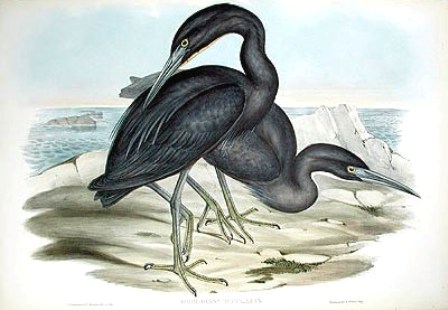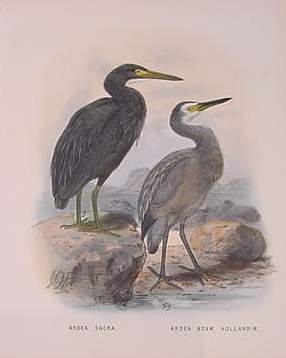
The reef heron was met at Queen Charlotte Sound in 1773 during Cook’s second voyage. It was described as Ardea matook by Viellot, who took his name from Forster’s rendering of the Maori name for the bird. Little more is heard of the species until Buller later decribed it.
Buller records: Captain Mair writes: “On Whale Island I saw some 30 of these birds and I found a number of their nests in a cave. Those that were fully fledged were a beautiful light blue colour, with bright yellow legs. It was very funny watching them flying into the high trees, perching among shags and looking very gawky; then presently, the shags, with loud gutteral noises, would sally forth, chasing them far and wide.” The crane’s cave as it is called, is open to the sea at the entrance, but it extends inwards some 30 feet and has an elevated or arched roof, and the nests of the herons are placed on the projecting ledges of rocks
The reef heron is quite widely distributed from Bangladesh to Korea and Japan, through the Pacific Islands to Australia. They are now quite rare in New Zealand.
Reef herons are dimorphic, with a dark phase and a white phase. The white phase is common in the Pacific whereas the dark phase is usual in New Zealand. They are coastal birds and are rarely seen inland.

Other common names: —
Pacific egret, eastern reef egret, Ardea sacra, Ardea jugularis Herodias Jugularis, Demigretta matook, Ardea matook.
Description: —
Native bird
66 cm., 400 g., slatey grey with yellowish bill and yellowish green legs; breeding plumes.
Where to find: —
Widespread but not common.
Poetry: —
So heavy
is the long-necked, long-bodied heron,
always it is a surprise
when her smoke-colored wings
open
and she turns
from the thick water,
from the black sticks
of the summer pond,
and slowly
rises into the air
and is gone.
Then, not for the first or the last time,
I take the deep breath
of happiness, and I think
how unlikely it is
that death is a hole in the ground,
how improbable
that ascension is not possible,
though everything seems so inert, so nailed
back into itself--
the muskrat and his lumpy lodge,
the turtle,
the fallen gate.
And especially it is wonderful
that the summers are long
and the ponds so dark and so many,
and therefore it isn’t a miracle
but the common thing,
this decision,
this trailing of the long legs in the water,
this opening up of the heavy body
into a new life: see how the sudden
gray-blue sheets of her wings
strive toward the wind; see how the clasp of nothing
takes her in.
— Mary Oliver
Illustration description: —
Gould, Birds of Australia, 1840-48.
Buller, Walter Lawry, Birds of New Zealand, 1st edition, 1873.
Reference(s): —
Heather, B., & Robertson, H., Field Guide to the Birds of New Zealand, 2000.
Oliver, W.R.B., New Zealand Birds, 1955.
Buller, Walter Lawry, Birds of New Zealand, 1888.
Page date & version: —
Monday, 26 August 2019; ver2009v1

